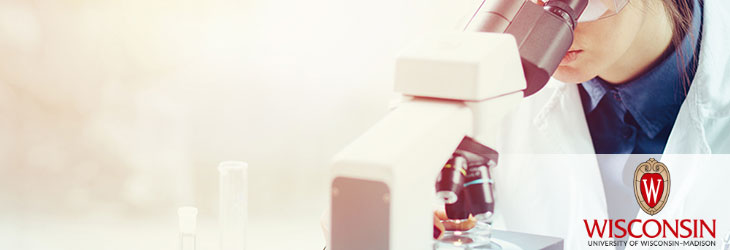Analytical Instrumentation, Methods & Materials

Varied Monodisperse Oil or Liquid Crystal Emulsion Droplets for Improved Nanoviewing, Sensing and Biosensors
WARF: P08136US
Inventors: Nicholas Abbott, Frank Caruso, Jugal Gupta, Sri Sivakumar
The Wisconsin Alumni Research Foundation (WARF) is seeking commercial partners interested in developing methods for producing oil emulsion droplets, including monodisperse liquid crystal emulsion droplets, with uniform, predetermined sizes.
Overview
Controlled micrometer-scale oil droplets have applications in nano-materials, meso-materials, responsive materials, optical materials, filters, sensors and opto-electronic technologies. Emulsion droplets can be prepared by various techniques. However, most approaches result in polydisperse emulsions, emulsion droplets with limited control over size or interfacial properties, or the formation of polymerized droplets. New techniques that enable the production of large quantities of oil emulsion droplets with controlled properties are needed.
Liquid crystal materials are promising candidates for many sensing and interfacial applications. Liquid crystals respond to and amplify small changes in temperature, electric or magnetic fields, shear or structure at the interface where they contact another material. They serve as “molecular magnifying glasses,” allowing events that occur at the nanoscale to be observed by the naked eye. If liquid crystals could be formed as monodisperse droplet emulsions with finely controlled size and surface chemistry, it could enable new sensing and interfacial technologies, including new types of biosensors.
Liquid crystal materials are promising candidates for many sensing and interfacial applications. Liquid crystals respond to and amplify small changes in temperature, electric or magnetic fields, shear or structure at the interface where they contact another material. They serve as “molecular magnifying glasses,” allowing events that occur at the nanoscale to be observed by the naked eye. If liquid crystals could be formed as monodisperse droplet emulsions with finely controlled size and surface chemistry, it could enable new sensing and interfacial technologies, including new types of biosensors.
The Invention
UW-Madison researchers have developed a versatile, scalable and highly parallel method of producing monodisperse emulsion droplets in a range of predetermined sizes. The oil emulsion droplets, in which the oils can be liquid crystal molecules, can be prepared with or without polymeric shells or capsules.
This method is based on templating polyelectrolyte multilayer (PEM) capsules formed by the layer-by-layer adsorption of polyelectrolytes on sacrificial particles. A polymeric shell is formed around a sacrificial particle, such as silica. Then the silica is etched away and the shell is infiltrated with an oil. The shell then can be removed to reveal monodisperse oil or liquid crystal emulsion droplets of a uniform, predetermined size. These droplets could be used as biosensors to detect enzymatic activity or target analytes, such as bacteria or viruses, in a sample.
This method is based on templating polyelectrolyte multilayer (PEM) capsules formed by the layer-by-layer adsorption of polyelectrolytes on sacrificial particles. A polymeric shell is formed around a sacrificial particle, such as silica. Then the silica is etched away and the shell is infiltrated with an oil. The shell then can be removed to reveal monodisperse oil or liquid crystal emulsion droplets of a uniform, predetermined size. These droplets could be used as biosensors to detect enzymatic activity or target analytes, such as bacteria or viruses, in a sample.
Applications
- Liquid crystal droplet-based biosensors for the detection of analytes, such as bacteria or viruses, in a sample
- New types of liquid crystal compositions, including monodisperse solutions
- Multilayer-coated oil emulsion droplets with functionalized surfaces for sensor and opto-electronic technologies
Key Benefits
- Rapid, parallel and scalable, enabling the preparation of large quantities of emulsion droplets
- Provides the ability to readily prepare monodisperse droplets in a wide range of sizes, as capsule templates can be prepared with diameters as small as 50 nanometers and as large as millimeters
- Droplet shape may be controlled through the use of non-spherical sacrificial particles.
- Allows preparation of emulsion droplets of different compositions with well-defined surface functionality
- Granulomeric distribution of droplets may be less than 10 percent.
Stage of Development
This method has been demonstrated with liquid crystals and silicon, paraffin and cooking oils.
Publications
For current licensing status, please contact Jennifer Gottwald at [javascript protected email address] or 608-960-9854
- Sivakumar S., Wark K.L., Gupta J.K., Abbott N.L. and Caruso F. 2009. Liquid Crystal Emulsions as the Basis of Biological Sensors for the Optical Detection of Bacteria and Viruses. Adv. Funct. Mater. 19, 2260-2265.
- Gupta J.K., Sivakumar S., Caruso F. and Abbott N.L. 2009. Size-Dependent Ordering of Liquid Crystals Observed in Polymeric Capsules with Micrometer and Smaller Diameters. Angew. Chem. Int. Ed. 48, 1652.